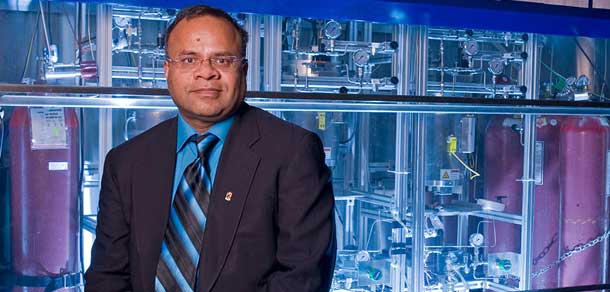Dr. Ajay Dalai, P.Eng. Photo: University of Saskatchewan
USask’s Ajay Dalai, P.Eng. is one of Canada’s longest-serving Canada Research Chairs (CRC)
This article first appeared on the University of Saskatchewan’s College of Engineering webpage.
Dr. Ajay Dalai, P.Eng., was a petroleum engineer early in his career at the University of Saskatchewan (USask) College of Engineering when he was asked to explore a new research path – bioenergy and its environmental benefits.
It has been a successful 20-year journey.
Dalai is one of Canada’s longest-serving Canada Research Chairs, having been the CRC in Bioenergy and Environmentally Friendly Chemical Processing since 2001.
His work has made him a world leader in efforts to develop alternative energy sources. He has been awarded more than $36 million in funding from the Natural Sciences and Engineering Research Council of Canada and other competitive sources.
“It has worked out really well, not only for me but for the department, the college and the university,” said Dalai, a distinguished professor in the Department of Chemical and Biological Engineering. “We have brought a lot of new knowledge over the last 20 years to the world.”
Dalai began as a Tier 2 chair on July 1, 2001. He and the six other researchers became USask’s first ever CRCs that year. Of that group, only Dalai remains. This makes him the longest-serving CRC at USask.
Though Dalai was trained as a petroleum engineer, he was asked to develop a CRC application focused on bioenergy – renewable energy generated from organic matter. Dalai knew little about it and recalled that it was not on the radar of provincial or federal governments.
“I looked at determining what is the environmental benefit, the financial benefit?” he said. “What is the benefit to industry? Canada has a lot of natural resources, but we didn’t have a lot of technology to transfer these resources into value-added products that can bring in money for farmers.”
In 2009, Dalai became a Tier 1 CRC. His large research group – he supervises more than 30 people every year – now works in three theme areas: Bioenergy, heavy oil processing and environmental engineering.
Significant achievements include:
- Developing a catalyst, in collaboration with Dr. Hui Wang, P.Eng., M.Sc., from his department, to transform carbon dioxide and methane – potent greenhouse gases – into synthesis gas, or syngas, which is a basic feedstock for producing gasoline and other fuels.
- Developing a method to produce biodiesel from low-cost raw materials such as waste cooking oil, soya, green seed canola and mustard with reduced water usage.
Dalai said it’s rare to find researchers working in both petroleum and bioenergy and points with satisfaction to a successful 10-year collaboration with SaskPower and the Saskatchewan Research Council to reduce mercury in flue emissions at the Boundary Dam Power Station and a 25-year relationship with Syncrude Canada.
“We’re not only strong in bioenergy, but we’re very strong in petroleum research and in pollution control,” he said.
Dalai’s research program is an example for other researchers, said Dr. Terry Fonstad, P.Eng., FEC, FGC (Hon), Associate Dean of Research and Partnerships at the College of Engineering.
“His work has shaped our research mission,” Fonstad said. “He impacts key industries in our province, including agriculture and oil and gas and shows how expertise from USask Engineering is playing a critical role in for the economies of our province and our country.”
